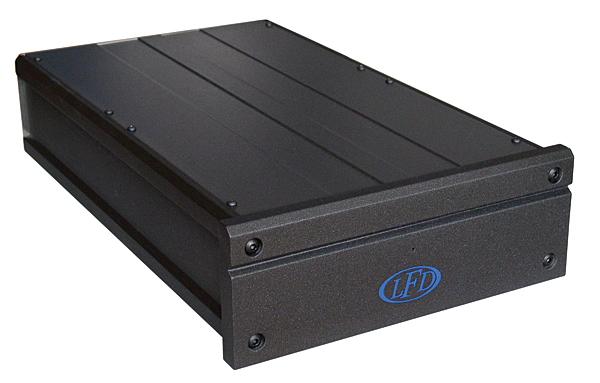| Columns Retired Columns & Blogs |
LFD Phonostage LE phono preamplifier

Far be it from me to surrender these column inches to the whims of a manufacturer.
Footnote 1: Dr. Malcolm O. Hawksford, "Fuzzy Distortion in Analog Amplifiers: A Limit to Information Transmission?," The Journal of the Audio Engineering Society, October 1983.
That said, there's ample reason to break with tradition and offer the thoughts of an obscure English company called LFD, whose products may already have tripped your surveillance wires. In their "Charter to Product Commitment and Traditional Values"—which can be read in its entirety on Frohmusik's website and is signed by Bews and Hawksford (see below)—the people of LFD suggest, in so many words, that they will not manufacture goods outside of their native England; that their design work is guided by listening as much as by engineering theory; that they believe some component parts sound better than others of identical numeric value, depending on their specific role in an audio circuit; that their philosophy of circuit design is decidedly minimalist; and that they advocate the enjoyment of music on vinyl LP. That the principals of LFD have thus far avoided being burned alive as heretics is a source of wonder.
Those principals are Dr. Richard Bews, who serves as LFD's managing director, and the well-known audio engineer Dr. Malcolm O. Hawksford, LFD's technical director. Some of you know Dr. Hawksford as the director of postgraduate studies in electronics engineering at Essex University, or from his articles in Stereophile, or as an especially distinguished member of the Audio Engineering Society. It was, in fact, from one of the papers Dr. Hawksford delivered to the AES that LFD got its name: Low Fuzzy Distortion (footnote 1). (In this context, fuzzy means random, though that's not to say the more common definition might not also apply.)
Description
It turns out that LFD has been around for nearly a decade: surprising news, given their low profile, itself a function of the company's insistence on constructing their products bench style, one at a time. Indeed, though their amps and preamps use printed circuit boards, LFD is that rare maker of solid-state electronics that acknowledges and, where possible, exploits the superiority of point-to-point wiring.
At the same time, LFD has no particular fear of op-amps, a stereo pair of which is used in the product under review: the Phonostage LE ($1295). According to Richard Bews, the NE5534 op-amp chip that provides voltage gain in the Phonostage LE was chosen specifically for its sound quality—and because it can be used to produce the desired DC offset for biasing the preamp's output-coupling capacitor. At the input end, a high-end Beyschlag resistor establishes the cartridge load, while the RIAA equalization network uses new-old-stock Bayer/WIMA polycarbonate capacitors. LFD apparently had the good sense to squirrel away those parts over the years: shades of Shindo.
The power supply is simple—and, according to Bews, a bit unusual: "Regulators are used to reduce noise," he says, "but [are] then followed by a large RC filter, which seems to produce a smoother sound compared to just regulators with small decoupling capacitors on their outputs." The Phonostage's PCB employs a star-ground scheme, and all wiring between it and the various other components is PC-OCC, which LFD says is made to their specifications in the Far East. A small frame-type transformer by VTX supplies the juice.
With the possible exception of the 47 Laboratory Gaincard, the LFD Phonostage is indeed as minimalist as they come: 28 resistors, 24 capacitors, 4 regulators, 2 epoxy diodes, 2 op-amp chips, and 1 transformer, all in a pleasant-looking but by no means opulent chassis made mostly of panels of extruded aluminum. Build quality was fine—happily, someone went to the trouble of tapping the screw openings in the extrusions, rather than counting on "self-tapping" metal screws to do the job for them—and most surfaces were finished in an attractive dark-gray textured paint. An exceedingly small, blue LED on the front panel reminds the user that the Phonostage LE is powered up, a state attained as soon as it's plugged in: Like most other high-end audio products that don't consume a great deal of current, the Phonostage lacks a power switch.
Installation and setup
The manual supplied with the LFD Phonostage LE is a simple thing: one page of Please do this, Please don't do that, and Thank you for buying our product. Things to do include leaving the Phonostage LE powered up all the time and keeping it at least a half-meter away from other electronic components, in order to prevent induced hum. Things not to do include asking the Phonostage LE to drive interconnects longer than 2–3m, or allowing oneself to fidget over the product's fixed 47k ohm input impedance. (In LFD's opinion, the quality of an input resistor has far greater influence on sound than its specific value.)
Footnote 1: Dr. Malcolm O. Hawksford, "Fuzzy Distortion in Analog Amplifiers: A Limit to Information Transmission?," The Journal of the Audio Engineering Society, October 1983.
- Log in or register to post comments




































